Modern water pipers are rarely made from metal. He had decent competitors - polymers who gradually displacing it in many areas. One of these materials is low pressure polyethylene. From this material make pipes for pressure pipelines, that is, for water pipes and even for gas pipelines. This type of material is becoming increasingly popular, as the connection of polyethylene pipes is easy to make it yourself. It is only necessary to observe very simple rules.
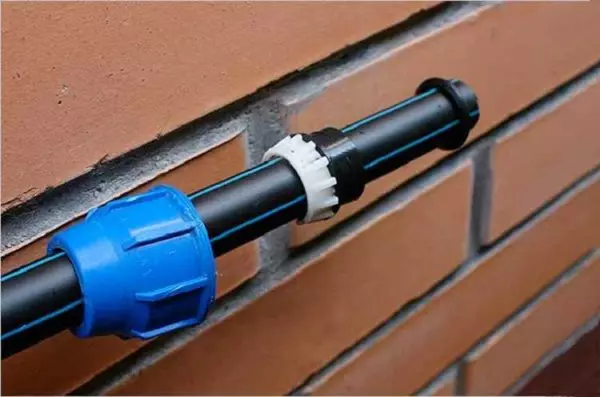
When organizing water supply of private Ohm, the PND tubes often use
Advantages and features of application
Polyethylene pipes are made of low pressure polyethylene. Abbreviated this material is labeled as a PND. It has high strength and elasticity, has good performance properties:
- chemically neutral, can be used to transport food;
- Smooth walls prevent the formation of plaque inside;
- not subject to corrosion;
- A small thermal expansion coefficient is about 3% with maximum heating (up to + 70 ° C);
- We react normally on the freezing of water inside, due to elasticity increase in diameter, and after thawing, the initial dimensions are taken.
One moment to remember! If you need pipes, resistant to freezing (for example, for the water supply device in the country), see the description or specifications. Not all types of copolymers, which are used to produce pipes, normally transfer freezing. So be careful.
The main disadvantage of polyethylene pipes is the temperature limitations of the transported environment: it should not be higher than + 40 ° C, that is, it is possible to make only a cold water supply line from the PND, and, moreover, it is impossible to use them.
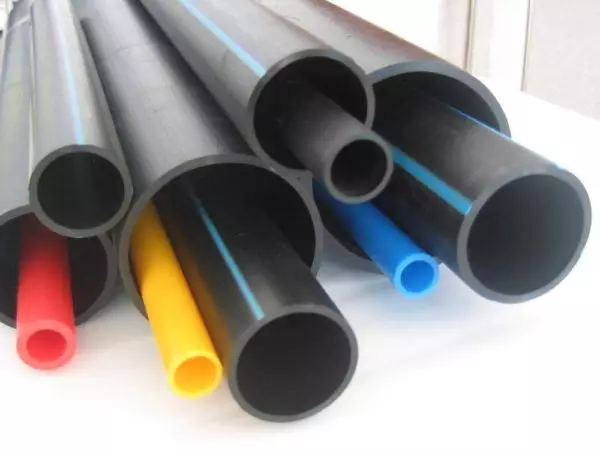
Polyethylene tap pipes are different diameters
Another point: Polyethylene does not tolerate UV radiation. With constant finding in the sun, the material loses elasticity, and, after some time, breaks (some manufacturers make PND pipes resistant to ultraviolet, but they are more expensive). Therefore, the open gasket of the water pipe from plastic pipes is very undesirable. But to spend the pipe into the trench from the well or well to the house, make a wiring of cold water around the house it is very possible. This is a rather economical and convenient solution, since the installation and connection of polyethylene pipes is not very complex. If we are talking about a detachable connection, no equipment need for it. We need only fittings and hands.
Article on the topic: Terracotta wallpaper: Brick shades in the interior
What plastic pipes are better
For the production of plumbing pipes, polyethylene two stamps is used - re 80 and re 100. The cellular polyethylene is more dense and durable than the eightieth. For the water supply systems of the private house of the strength of PE 80 more than enough - they withstand pressure up to 8 atm. If you like a large margin of safety, you can take them from PE100. They normally work at 10 atm.
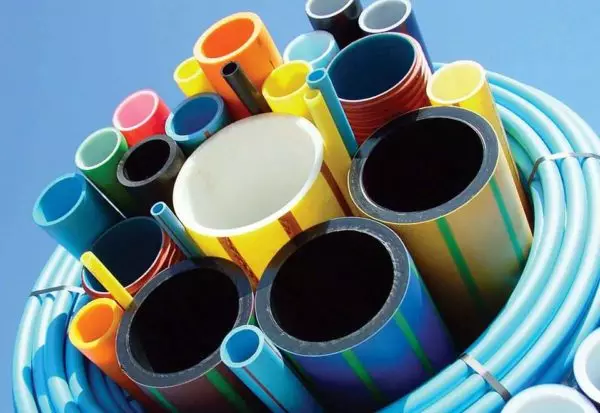
You need to choose first of all manufacturer
What is worth paying attention to - on the country in which this product is produced. Quality leaders are European manufacturers. High performance accuracy guarantees high system reliability. The average quality and price is the Turkish campaigns, in a cheaper price segment, the Chinese manufacturer. The quality of them, as usual, is also much lower. Tips here are difficult to give, each selects at its own discretion (or what is in the region).
Types of PND pipe connections
The connection of polyethylene pipes has several types of species:
- detachable (on fittings or couplings);
- Inspected - welding:
- using a special welding machine;
- Electric couplings - the heater is built into the inside of such couplings when the electric current is supplied, the polyethylene is heated and melted.
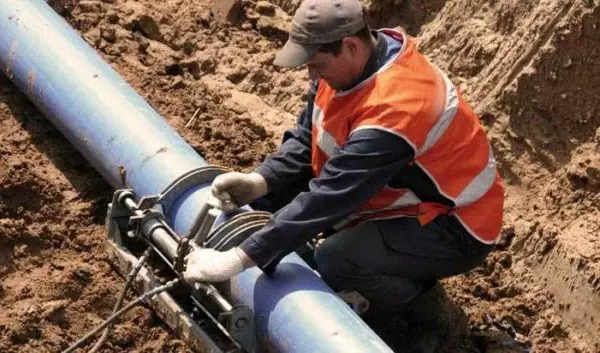
Welding applies more often on large diameters
Weld in the main pipe of large diameters, which are used to create trunk pipelines. Pipes of small diameters - up to 110 mm used in private construction, for the most part combined with fittings. Couplings are used more often during repair work, as their installation takes longer.
Fittings for polyethylene pipes are fittings (tees, crossmen, corners, adapters, couplings) with which the desired system configuration is created. Since the independent connection of polyethylene pipes is carried out more often with the help of fittings, let's talk about them in more detail.
Article on the topic: How to measure rolled curtains: specialist advice
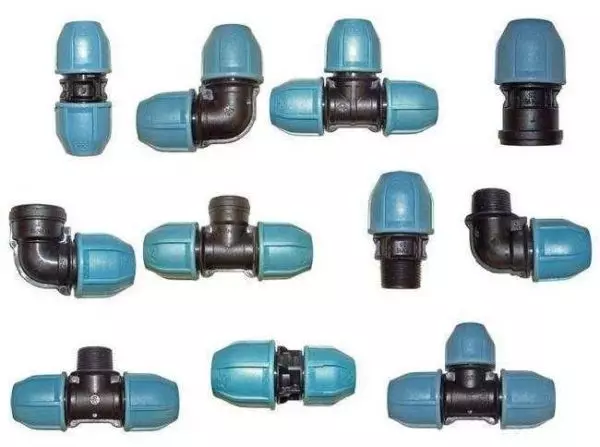
Approximate set of fittings for water polyethylene pipes
Build on compression (crimping) fittings
With one or two sides of the fitting (sometimes from three), a whole system is installed, which provides a connection. The fitting itself consists of:
- hull;
- clamping nut;
- Canggi is a plastic ring with a slanting, providing tight pipe coverage;
- stubborn rings;
- Gaskets, which is responsible for tightness.
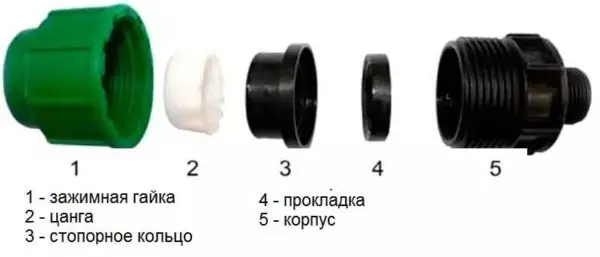
What is compression fitting for polyethylene pipes
How reliably the connection
Despite the apparent unreliability, the compression of polyethylene pipes on compression fittings is reliably. Properly made, it withstands the working pressure up to 10 atm and higher (if it is a product of a normal manufacturer). Watch video.It is good for this system with ease of self-installation. You probably appreciated it by video. Just pipe is inserted, thread is dragged.
Dachnikov, besides the opportunity to do everything with their Urms, she likes that, if necessary, everything can be disassembled, hide for the winter, and in the spring again collect. This is the case if the wiring is made for watering. The collapsible system is also good because you can always tighten the feeding fitting or replace it with a new one. The disadvantage - the fittings of the bulk and the inner layout in the house or apartment of them are rare - the appearance is not the most pleasant. But for the plot of water supply - from the well to the house - it is better to find the material to find.
Order assembly
The pipe is cut strictly at 90 °. The slice should be smooth, without burr. Also unacceptably the presence of dirt, oils or other pollutants. Before assembling from cuts of the connected areas, a chamfer is removed. It is necessary so that the sharp edge of polyethylene does not damage the sealing rubber ring.
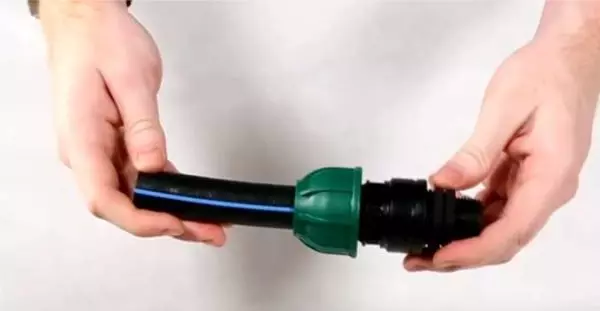
When installing the connection of polyethylene pipes on crimping fittings is tightened by hand
Spare parts are put on the prepared pipe in this order: the crimp nut is stretched, then the collet, follow-up - a stubborn ring. Rubber gasket Install in the fitting housing. Now the housing and the pipe with the details we connect with the details, the applied force - it is necessary to insert until it stops. Tighten all parts to the case and with the help of crimp nuts connect. The resulting connection of polyethylene pipes spin with force with their hands. For reliability, you can reach a special assembly key. The use of other suspended tools is undesirable: you can damage plastic.
Bendelki and their scope
In addition to fittings, there is another interesting device that allows you to make branches from the finished pipeline. These are saddles - specially designed couplings. On this clutch there is one or more threaded holes. They usually put a crane, and a new branch of the water supply is connected to it.
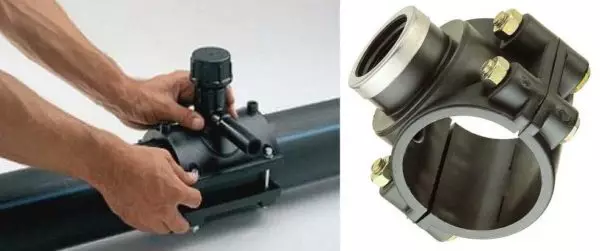
Sadelles for polyethylene water pipes
Cedeks are put on the pipe, fastened with screws. After that, in the branch of the drill and a thick drill on the surface of the pipe, the hole is drilled. When it is ready, the crane is installed, the branch is going on. So improve the system with minimal efforts and costs.
Flange compounds and transition to metal
In the plumbing, elements of the system that have no threaded, and the flange connection can be installed. These are usually cranes or other shut-off or regulating fittings. To connect with such elements there are special fittings for the PND. On the one hand, the compression option is standard, on the other - the flange. Installation is standard - with a crimp nut on one side, gaskets and bolts on the side of the flange.
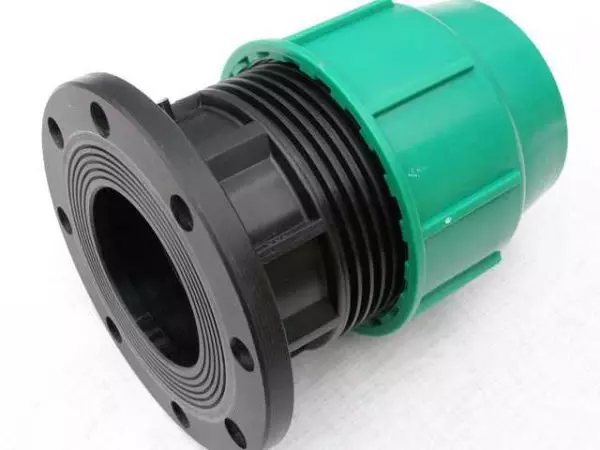
Flange Flange Compound PND
When the water supply device from polyethylene pipes may also include questions about the compound of polyethylene and metal. For these cases, fittings are used, on the one hand there is a thread. It can be outer or internal - depends on the type of device being installed or transition. Such fittings are straight, there is an angle of 90 °.
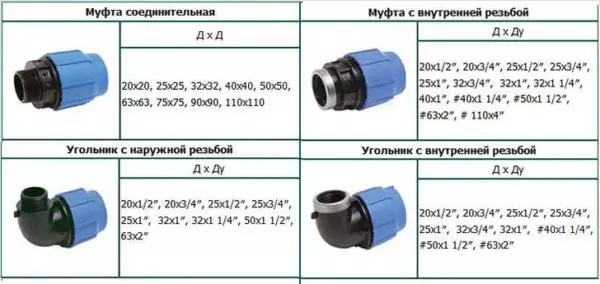
Fittings for transitioning with HDPE for metal
Installation Standard - thread (with winding neatly) on one side and crimp nut on the other.
Article on the topic: Illumination of door handles with their own hands in the car
